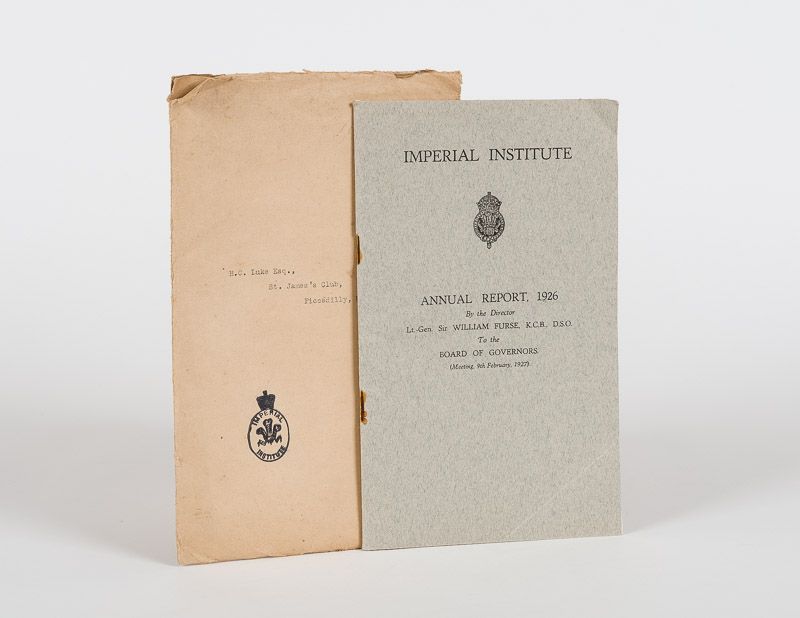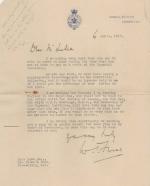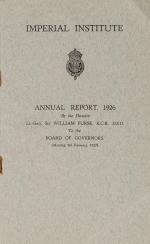[Luke, Imperial Institute: Annual Report, 1926.
Imperial Institute: Annual Report, 1926. [With Typed Letter, signed (TLS) by Sir William Furse to Sir Harry Luke]. By the Director Lt.-Gen. Sir William Furse, K.C.B., D.S.O., To the Board Of Governors (Meeting, 9th February, 1927).
[This item is part of the Sir Harry Luke – Archive / Collection]. London, Imperial Institute, 1927. 25 cm x 15 cm. II, 46 pages. Original Softcover. Harry Luke’s (Lukach) personal copy. Good condition with some minor signs of external wear.
Includes a letter from Sir William Furse to Harry Charles Luke consisting of an invitation to help Sir William Furse on the spot about the re-arrangement in Exhibition Galleries and also stating he is sending this Annual Report to him in case it may be of some interest to him.
Serveral sections in the publication deal with commodities coming out of Colonies like Sierra Leone etc.
It also includes a Comparative Statement of Estimates and actual Receipts and Expenditure for the nine months April 1st to December 31st, 1926. This Annual Report, 1926 comes with an envelope addressed to H.C. Luke Esq., St. James’s Club, Piccadilly, W.L.
Lieutenant General Sir William Thomas Furse, KCB, KCMG, DSO (21 April 1865 – 31 May 1953) was a senior British Army officer who served as Master-General of the Ordnance during the First World War.
Furse was commissioned into the Royal Artillery as a lieutenant on 5 July 1884. He was aide-de-camp to Lord Roberts from 1891 to 1893, and was promoted to captain on 30 May 1893.
Furse served during the Second Boer War as a Deputy Assistant Quartermaster General (DAQMG) at Army Headquarters, and was promoted to major on 15 March 1900. Following the end of the war in June 1902, Furse was on 15 October appointed DAQMG to the 2nd Army Corps based at Salisbury Plain. In 1911 he was appointed commander of the 12th (Howitzer) Brigade Royal Field Artillery.
Furse served in the First World War, initially as a General Staff Officer on the British Expeditionary Force and then as General Officer Commanding 9th (Scottish) Division from 1915. He was made Master-General of the Ordnance in 1916; in this capacity he opposed the introduction of the Madsen machine gun, preferring the Lewis gun. He retired in 1920. (Wikipedia)
- Keywords: Autograph – British History · Autograph – Rare · British Colonial Administration · British Colonial History · British Foreign Office · British Foreign Policy · Harry Luke – Sierra Leone II (1924 – 1928) · Luke, Sir Harry · Middle East · Middle Eastern History – Rare · Military History · Military History – Rare · Sierra Leone · Sierra Leone / Sir Harry Luke Collection · Sierra Leone Content (Autographed Letter Signed – ALS) · Sierra Leone Content (Printed Chapters) · Sierra Leone Content / Second Posting 1924-1928 – Sir Harry Luke · Sir Harry Luke · Sir Harry Luke – Personal Archive of Books and Correspondence · Sir Harry Luke Collection · TLS · Typed Letter signed
- Language: English
- Inventory Number: 30110AB
EUR 28.000,--
© 2025 Inanna Rare Books Ltd. | Powered by HESCOM-Software














